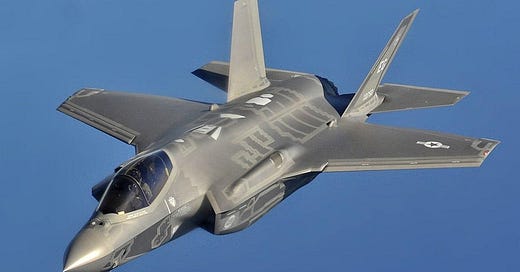The F-35 as a Subscription Service: Power, Dependency, and Strategic Control… DaaS, Defense as a Service.
by Benjamin Cook (into by Tom Cooper)
The publication of the feature (No) Kill Switch, a few days ago, seems to have ‘hit the nerve’: it said ‘in clear’ something one is not going to hear from any of involved officials. Not even from the mass of the mainstream media. Unsurprisingly, it prompted many questions.
Benjamin is taking care to answer these and explain the repercussions.
***
When countries purchase the American-made F-35 fighter jet, they aren't just buying an aircraft—they're subscribing to an ecosystem. The F-35 isn't merely a stealth jet with superior aerodynamics; its true power lies in its ability to network, process, and act on actionable intelligence. Without this network, the F-35's value diminishes significantly. In this sense, owning an F-35 is less about military hardware and more about subscribing to an American-led defense architecture.
The Subscription Model Analogy
Imagine buying a state-of-the-art smartphone, but its full functionality is locked behind a subscription service. The hardware is impressive, but the value lies in the constant updates, cloud services, and access to a broader network. Without the subscription, you're left with a device that underperforms and slowly becomes obsolete. The F-35 operates in much the same way.
The initial purchase of the F-35—the jet itself—is like the upfront cost of buying that smartphone. It's expensive, sleek, and impressive. However, the true operational capability only comes with continuous access to:
Software Updates: The F-35 is driven by complex software systems that require constant updates to maintain operational effectiveness, security, and functionality. Without these updates, the jet's capabilities degrade over time.
Actionable Intelligence: The F-35 is designed to integrate seamlessly with U.S. and allied ISR (Intelligence, Surveillance, Reconnaissance) networks. Without access to this data stream, much of the F-35's advantage in situational awareness disappears.
Maintenance and Parts: The jet relies on a tightly controlled supply chain managed by the U.S. and its defense contractors. Ongoing maintenance, replacement parts, and technical support are essential to keeping the aircraft mission-ready.
Security Patches: Cybersecurity is crucial for a data-heavy platform like the F-35. The U.S. controls the security protocols and patches, meaning any vulnerability is managed centrally.
Each of these elements functions as a component of the "subscription." Lose access to any of these, and the value of the F-35 is severely diminished.
Hate Subscriptions? Me too! You can support me with a one time contribution to my research at Buy Me a Coffee. https://buymeacoffee.com/researchukraine
The Risks of Being "De-Platformed"
The subscription model introduces significant geopolitical risk. The United States retains ultimate control over the F-35 network, meaning it can "de-platform" a nation if relations deteriorate. The case of Turkey illustrates this perfectly. After Ankara purchased the Russian S-400 air defense system—deemed a security risk by the U.S.—Turkey was expelled from the F-35 program. The U.S. cut off access to software, parts, and updates, rendering Turkey's F-35 ambitions null.
This risk forces countries to consider not just the upfront cost of the jet but the long-term political and strategic alignment with the United States. Owning an F-35 means adhering to U.S. defense policies and strategic priorities. Failure to do so can result in being cut off from the vital updates and information streams that keep the aircraft effective.
***
Control vs. Capability
Countries that invest in the F-35 must balance the pursuit of military capability against the loss of strategic autonomy. While the F-35 offers unparalleled technological superiority, it also binds nations to the U.S. defense ecosystem.
In contrast, some nations have found ways to enhance autonomy even when starting with U.S.-designed platforms:
● Japan's Mitsubishi F-2: Based on the F-16, Japan's F-2 is larger, incorporates indigenous avionics, and utilizes advanced composite materials for stealth and durability. It also features Japan-developed radar systems, allowing for greater self-reliance in manufacturing and operations.
● Israel's F-35I Adir: Israel secured the unique right to modify its F-35s. The F-35I includes Israeli-designed electronic warfare systems, sensors, and weapons, enhancing operational independence and ensuring that Israel can tailor the platform to its unique threat environment.
These examples show that some nations strive for autonomy even within U.S.-controlled frameworks, negotiating terms that allow greater self-sufficiency.
***
The Hidden Costs of Subscription Dependence
The initial acquisition of the F-35 is just the beginning. Ongoing costs related to software upgrades, maintenance, and intelligence sharing can be substantial. Moreover, this dependency means that countries cannot operate the F-35 entirely on their own terms. Any political divergence from Washington risks the suspension of essential services, leaving an expensive but underperforming fleet.
This raises an important strategic question: Why invest in a platform that can be deactivated by another country's political decision? Why commit to a system where sovereignty is, to some extent, compromised?
***
The Strategic Dilemma
For smaller nations, buying an F-35 means entering a long-term defense subscription with the United States. This provides advanced capabilities but also exposes them to significant leverage by Washington. If relations sour, the F-35 can be reduced to little more than an expensive, under-utilized platform.
In many ways, the F-35 is a tool of both defense and diplomacy. It strengthens alliances and ensures interoperability, but it also functions as a strategic tether. For nations seeking the most advanced combat capabilities, this tether may be worth it. For those valuing sovereignty and independence, it presents a dilemma: superior firepower at the cost of control.
***
The More You Know...
The F-35 isn't just a fighter jet; it's a subscription service with geopolitical strings attached. Nations that buy into the program gain access to unmatched aerial and data capabilities—but they also cede a measure of control to the United States. The question each country must ask is whether the benefits of the "subscription" outweigh the costs of dependency. Because when the subscription is canceled, the F-35 becomes little more than an expensive monument to what might have been.
Benjamin Cook continues to travel to, often lives in, and works in Ukraine, a connection spanning more than 14 years. He holds an MA in International Security and Conflict Studies from Dublin City University and has consulted with journalists on AI in drones, U.S. military technology, and related topics. He is co-founder of the nonprofit UAO, working in southern Ukraine. You can find Mr. Cook between Odesa, Ukraine; Charleston, South Carolina; and Tucson, Arizona.
Hate Subscriptions? Me too! You can support me with a one time contribution to my research at Buy Me a Coffee. https://buymeacoffee.com/researchukraine
Mr. Cook’s Substack:






Thanks Benjamin.
Here in Norway we, of course, went with the F-35. It will drain our military budgets as it's extremely expensive to purchase and operate. There is no chance that our politicians will switch them out.
We're buying frigates next, the US alternative is the worst choice, and may no be built anytime soon since the US has no yard capacity, and (of course) strong voices are clamoring for the US alternative. The only hope we have is that 47's unpopularity and erratic behavior leads us to a European alternative.
Thank you! When I read a number of coutries were considering canceling orders for a plane that US could mess with, it made no sense why anyone would buy into it.